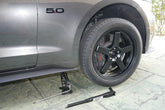Superchargers – What’s so SUPER about them?
When it comes to upgrades a Supercharger sounds sexy, but what's so alluring about this mystic engine mod? Our Technical Sales Advisor, Phil, brings you the first in a series of 'Supercharger Insights'...
First thing to know, is there is a lot to know about Superchargers. So for this first blog post I will try and keep things short and simple to ease you in.
Superchargers are a type of forced induction, engineered to increase the performance of a naturally aspirated engine. They have been around for a very long time, the first dating back to 1878 if you really must know! As technology has evolved, so have Superchargers. And it goes without saying, the modern-day Supercharger is significantly better and more efficient than back then (no, people didn’t have 700Bhp cars in the 19th Century).
The reason Superchargers are used? MORE POWER. So how do you get more power from an engine?
Well simply put, increase fuel and Oxygen to the engine. While increasing fuel can be simple and easy to do, improving Oxygen is a little more complex. The atmosphere only has a limited amount of Oxygen to draw in, so forced induction was invented to increase airflow into the engine, allowing it to burn more fuel and thus, produce more power.
Air intake kits do this well enough by improving the airflow on stock engines by filtering the air to remove defunct molecules and cool it, so your engine receives a higher Oxygen efficiency. Typically a Performance Cold Air Intake Kit will provide an additional 15HP (but we're not here to talk about them)... Because if you're after serious gains, the kind that boosts horsepower in the 100s, then a Supercharger is the thing!
These days the most common Supercharger uses 'Twin-Screw' technology. What's known as a positive displacement, it works by pushing air through a pair of meshing close-tolerance screws (or lobes). These lobes should never come into contact with each other, if they do you should probably pull over!
The other popular type is known as a 'Roots' Supercharger. They have a similar method of compressing air, however, the lobes do come into contact with each other, which with this friction comes heat - and lots of it! As a result, Roots Superchargers have the potential to reduce thermal efficiency. They are great at providing power but are deemed to be poorer in performance in comparison to a Twin-Screw Supercharger. Roots Superchargers are most commonly found of diesel vehicles.
The third type is the 'Centrifugal' Supercharger. They have a different design to the Roots and Twin-Screw, and are attached to the front of the engine via a belt or gear drive from the engine's crankshaft. This belt/drive will power an impeller or wheel, that will draw air into the housing. The centrifugal force of created will send air into a diffuser which becomes highly pressurised, but moves “slowly”. The pressurised air is then fed into the engine; this high pressure allows the engine to burn more fuel at a higher combustion level creating greater engine volumetric efficiency. The downside to a Centrifugal Supercharger is the fact it is driven by the engine, as a result at low RPM the Supercharger will not be spinning as quickly and any forced induction is reduced until a higher RPM. This is also common with Turbo systems, referred to as “turbo-lag” (more on that later).
That covers the basics of Supercharger engineering. If you're thinking about modifying your car be sure to speak to us for expert advice on everything that we offer.
We currently stock Superchargers by performance manufacturers Whipple and Roush for Ford Mustang GT 2015-17 and Ford Mustang GT 2018-19.
My next article will speak of the differences between the Superchargers offered by two of our most popular brands and discuss application to the Ford Mustang GT 2015-17 specifically. Watch this space.






